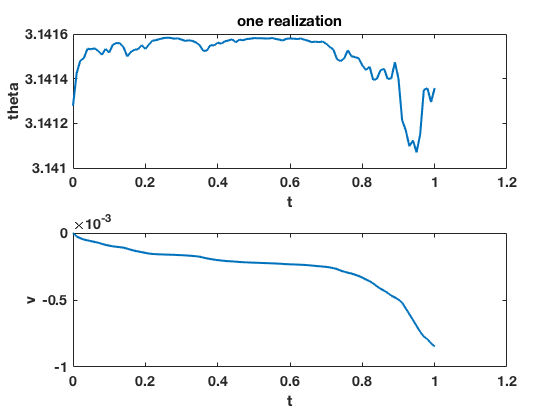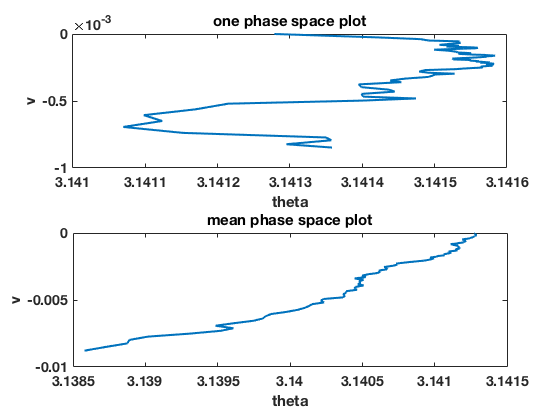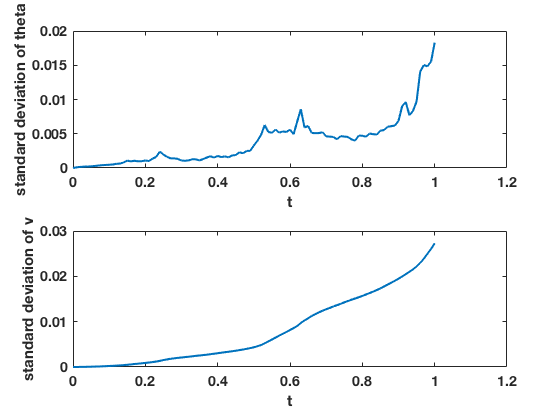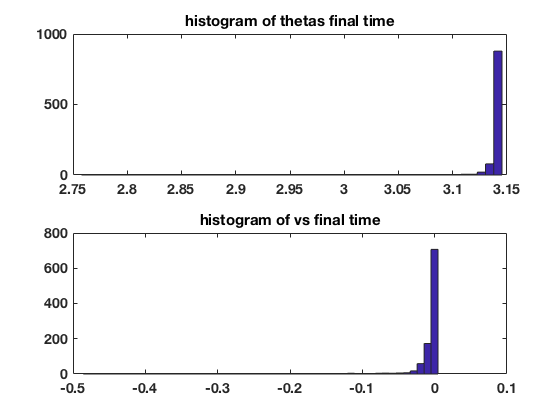The Stochastic Pendulum with white noise
This script is a tutorial script for stochastic integration and visualization using white noise.
Contents
- The governing ODEs of the damped pendulum are
- This section is all the book keeping for initialization
- The parameters for the white noise
- Initial conditions
- Set up arrays for storage and store initial state
- The main work horse loops. The double loop can be used view to intermediate results
- Now that we have the data we can make a variety of pictures
The governing ODEs of the damped pendulum are


 is taken to vary as
is taken to vary as  where the perturbation is white noise. This script uses the Euler-Maruyama method for solving the DE which uses Ito calculus. To use Ito calculus we write the system as:
where the perturbation is white noise. This script uses the Euler-Maruyama method for solving the DE which uses Ito calculus. To use Ito calculus we write the system as:
 (no stochastic component)
(no stochastic component)
![$$ v'=[-\frac{g}{l} \sin{\theta} - damping*v]*dt -
noiseamp*(g0/L)*sin(theta)*dW $$](stoch_pendulum_white_eq17559536742496297035.png)
Then discretize using the usual stochastic calculus way. This is opposed to Stratonavich calculus, however we can convert between the two using the Ito-Stratonovich drift correction formula:
 (Ito)
(Ito)
 (Stratonavich)
(Stratonavich)
where  . In this particular case
. In this particular case  does not depend on
does not depend on  and so
and so  .
.
This section is all the book keeping for initialization
Initialize the random number generator and seed it.
rng('shuffle');
Specify the global parameters for the pendulum.
length=1; g0=9.81; damp=1e-1;
Specify the time step and stochastic parameters.
numsteps=10; % Sets how many time steps between saves. numouts=100; % Sets the number of outputs. dt=1e-3; % Sets the time step. dtrt=sqrt(dt); % For the white noise.
Stochastic methods are low order so small time steps are required. Sets the number of ensemble members.
numens=1000;
The parameters for the white noise
Set the standard deviation of the noise.
mysig=0.35;
Initial conditions
% theta=2*pi*rand(numens,1); %initially assume random angles theta=(1-1e-4)*pi*ones(numens,1); % start near the unstable state % theta=1e-4*pi*ones(numens,1); % start near the stable state v=zeros(numens,1); % Initially assume zero velocity. t=0;
Set up arrays for storage and store initial state
thetas=zeros(numouts+1,numens); vs=zeros(numouts+1,numens); ts=zeros(numouts+1,1); thetas(1,:)=theta; vs(1,:)=v; ts(1)=t;
The main work horse loops. The double loop can be used view to intermediate results
for ii=1:numouts for jj=1:numsteps
Generate a new bunch of random numbers.
nowrand=randn(numens,1)*mysig;
Define the rhs for the DE.
rhth=v;
The deterministic part.
rhv=-(g0/length).*sin(theta)-damp*v;
The stochastic part.
rhvstoch = (-g0/length).*sin(theta);
theta=theta+dt*rhth+dtrt*nowrand.*rhvstoch;
v=v+dt*rhv;
t=t+dt;
end thetas(ii+1,:)=theta; vs(ii+1,:)=v; ts(ii+1)=t; end
Now that we have the data we can make a variety of pictures
figure(1) clf set(gcf,'DefaultLineLineWidth',2,'DefaultTextFontSize',14,... 'DefaultTextFontWeight','bold','DefaultAxesFontSize',14,... 'DefaultAxesFontWeight','bold'); subplot(2,1,1) plot(ts,thetas(:,1)) xlabel('t') ylabel('theta') title('one realization') subplot(2,1,2) plot(ts,vs(:,1)) xlabel('t') ylabel('v')

figure(2) clf set(gcf,'DefaultLineLineWidth',2,'DefaultTextFontSize',14,... 'DefaultTextFontWeight','bold','DefaultAxesFontSize',14,... 'DefaultAxesFontWeight','bold'); subplot(2,1,1) plot(thetas(:,1),vs(:,1)) ylabel('v') xlabel('theta') title('one phase space plot') subplot(2,1,2) plot(mean(thetas,2),mean(vs,2)) ylabel('v') xlabel('theta') title('mean phase space plot')

figure(3) clf set(gcf,'DefaultLineLineWidth',2,'DefaultTextFontSize',14,... 'DefaultTextFontWeight','bold','DefaultAxesFontSize',14,... 'DefaultAxesFontWeight','bold'); subplot(2,1,1) plot(ts,std(thetas,[],2)) ylabel('standard deviation of theta') xlabel('t') subplot(2,1,2) plot(ts,std(vs,[],2)) ylabel('standard deviation of v') xlabel('t')

figure(4) clf set(gcf,'DefaultLineLineWidth',2,'DefaultTextFontSize',14,... 'DefaultTextFontWeight','bold','DefaultAxesFontSize',14,... 'DefaultAxesFontWeight','bold'); subplot(2,1,1) mnth=min(thetas(end,:)); mxth=max(thetas(end,:)); bins=linspace(mnth,mxth,floor(numens/20)+1); hist(thetas(end,:),bins) title('histogram of thetas final time') subplot(2,1,2) mnv=min(vs(end,:)); mxv=max(vs(end,:)); bins=linspace(mnv,mxv,floor(numens/20)+1); hist(vs(end,:),bins) title('histogram of vs final time')
